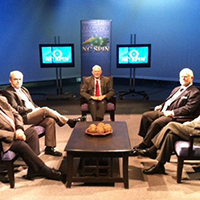What will North Carolina's future be?
Published November 2, 2023
By Tom Campbell
Two recent headlines grabbed my attention. The first was the announcement that Toyota, having already announced a major project to build batteries for electric vehicles in Randolph County, has expanded their plans. Next was the revelation that North Carolina had the third fastest population growth of all states in 2022. Both speak to our future.
The Japanese auto company had already announced that their new Liberty plant would invest $1.29 billion into battery production and hire 1,750. Following Governor Cooper’s recent successful economic development mission to Japan, Toyota’s President Sato proclaimed the North Carolina project would invest an additional $8 billion and hire an additional 5,000 jobs, making this the largest single economic development project in the history of our state.
North Carolina’s recent economic development announcements have come at an almost dizzying pace and include Vinfast, the Vietnamese auto maker, that will invest some $4 billion and hire 7,500 at their Chatham County production facility. Boom Supersonic projects to hire 1,750 building jet airplanes at its $500 million investment in Guilford County. Wolfspeed, the semiconductor manufacturer will invest billions and employ 1,800. And the list includes Apple (3,000 jobs), Fidelity investments (1,500 jobs), Google (1,000 jobs) and others. North Carolina has never seen so much economic activity in such a short period.
The Census Bureau updated population growth for 2022 at 133,088, ranking us behind Texas and Florida. We are now home to 10,698,973 people and Michael Cline, state demographer, projects that North Carolina will have a population of 14 million by 2050. That means adding 122,000 new residents each year for 27 years, a meteoric pace. 100,000 of us currently turn 65 each year and by 2031 there will be more older adults than children. Our median age will increase from 35 in 2000, to 41 by 2050. Racial changes will also result as the white population shrinks from 62 percent to 52 percent in 2050, with Hispanics increasing from 11 to 14 percent.
All of this news promises a bright and exciting future for our state, but it also poses questions and concerns. Is our state prepared for such rapid changes? Do we have leadership thinking futuristically about how these changes will impact our state? What must be done?
A greatly increased population will place exponentially greater demands on a road system that, in too many instances, is already congested. Business as usual in road construction funding won’t be sufficient.
New residents will result in more housing units, in turn placing expanded demands on public utilities, especially clean water and sewer facilities. The electric power grid will require expansion and new waste disposal sites will be needed.
Our already stressed healthcare system will face major challenges. Nowhere will this be more urgent than in rural communities that have experienced hospital closures, sparse numbers of urgent care facilities and counties lacking care providers. We pay little attention to seniors now, but with an increased population over 65 their healthcare needs will become important. An aging population will demand more senior centers and assistance. All ages and races will demand more recreation facilities and parks.
And let’s look at education. While there will be some decline in numbers of school aged children there will be increased urgency to improve public education. Many aging school buildings need renovation or replacing and the shifts in population will require new school construction in more urban areas. Industries with new technologies will present increased demands for our community colleges to train or retrain our workforce. Higher education, already undergoing upheaval, will continue to compete for students and face budget constraints.
Here’s my spin: We are are not adequately meeting today’s public infrastructure needs. And if there are folks anticipating future needs, they are a well-kept secret. We always seem to be playing a game of infrastructure catch-up instead of getting ahead of the curve.
We have state legislative leadership intent on concentrating all power for themselves. They don’t want, don’t seek or heed input from local communities, business, educators or other sectors. The state has billions of dollars stockpiled in “rainy day” reserves but seems unwilling to appropriate money for meeting current public demands, much less those in the future. Instead, they continue to cut taxes, further restricting funds for those services which the public needs and deserves. Their own budget projections (not including the above growth projections) show the state facing revenue problems after 2025.
So, the exciting prospects for our future are dimmed by the lack of forward-thinking leadership. Candidates are now announcing themselves for election in 2024. We need to get them on the record, asking them to tell us their current and future vision for our state and how they plan for us to meet those needs. If the North Carolina of 2050 includes 14 million residents we need to know where candidates stand on these and other issues before giving them our votes.
Tom Campbell is a Hall of Fame North Carolina Broadcaster and columnist who has covered North Carolina public policy issues since 1965. Contact him at tomcamp@carolinabroadcasting.com.







